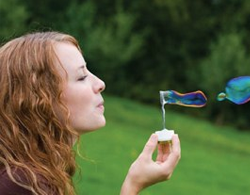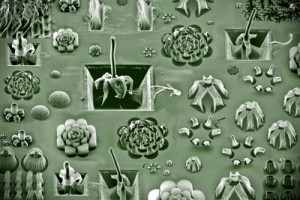Nanooze Blog
Tiny layer of glass
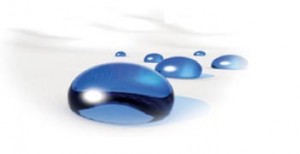 Nanotechnology is all about making things small—-and thin. So sometimes the magic is not making it tiny but making it incredibly thin, only a few atoms or molecules thick. The big thing about making thin things is making sure that even though it is thin, it is uniform, meaning no holes. And that is hard. Imagine spreading peanut butter just a few molecules thick? Tough. Now scientists have figured out how to make layers of glass only a few molecules thick. Glass is made of silicon dioxide and is pretty impermeable. A layer 15 to 30 molecules thick (about 1/500 the width of a hair) prevents bacteria from penetrating and so you could make a bacteria proof coating. It is also impermeable to water meaning it doesn’t stain. What is neat is that glass at that thickness is transparent (well that is not surprising) but it is also flexible! Meaning you could coat lots of different things. Maybe you wouldn’t want to eat it but it is might be useful for stain resistance or to make things really slick like the front end of a high speed train. http://tiny.cc/0uhtC
Nanotechnology is all about making things small—-and thin. So sometimes the magic is not making it tiny but making it incredibly thin, only a few atoms or molecules thick. The big thing about making thin things is making sure that even though it is thin, it is uniform, meaning no holes. And that is hard. Imagine spreading peanut butter just a few molecules thick? Tough. Now scientists have figured out how to make layers of glass only a few molecules thick. Glass is made of silicon dioxide and is pretty impermeable. A layer 15 to 30 molecules thick (about 1/500 the width of a hair) prevents bacteria from penetrating and so you could make a bacteria proof coating. It is also impermeable to water meaning it doesn’t stain. What is neat is that glass at that thickness is transparent (well that is not surprising) but it is also flexible! Meaning you could coat lots of different things. Maybe you wouldn’t want to eat it but it is might be useful for stain resistance or to make things really slick like the front end of a high speed train. http://tiny.cc/0uhtC
Plants Do It Already
 Plants are able to generate energy using photosynthesis. It is kind of the same general idea as what solar cells do except instead of generating electricity, plants generate chemical energy and store it for later use. Scientists have taken tobacco and by genetic engineering started to assemble the pieces that would be needed to make plants into solar energy generators. Still a long way away from their ultimate goal, the idea of using plants is neat and could be a more ecofriendly way of producing solar power. Some time you might be able to plant your own solar cells and power that iPod.
Plants are able to generate energy using photosynthesis. It is kind of the same general idea as what solar cells do except instead of generating electricity, plants generate chemical energy and store it for later use. Scientists have taken tobacco and by genetic engineering started to assemble the pieces that would be needed to make plants into solar energy generators. Still a long way away from their ultimate goal, the idea of using plants is neat and could be a more ecofriendly way of producing solar power. Some time you might be able to plant your own solar cells and power that iPod.
for more see
http://www.gizmodo.com.au/2010/01/tobacco-plants-used-to-grow-cheap-solar-cells/
Your Brain as a Mold
 You see them all the time. On bread left around for a while, between your toes. Molds. Dumb fuzzy things. Well not really. Scientists in Japan have taken tiny bits of food and made a map that was just like Japan. Then they took a blob of mold and put it in one place and watched the mold grow. It grew out looking for the food and creating a network that looked kind of like a communications or a transportation network. All without a central brain. Want to read all about it http://www.sciencemag.org/cgi/content/full/sci;327/5964/419
You see them all the time. On bread left around for a while, between your toes. Molds. Dumb fuzzy things. Well not really. Scientists in Japan have taken tiny bits of food and made a map that was just like Japan. Then they took a blob of mold and put it in one place and watched the mold grow. It grew out looking for the food and creating a network that looked kind of like a communications or a transportation network. All without a central brain. Want to read all about it http://www.sciencemag.org/cgi/content/full/sci;327/5964/419
No More Dirty Windows
Nanotechnology can potentially cure disease or lift a person into space, but on to more important stuff. Clean windows. Scientists from Israel have been working on a coating that is self-cleaning. Using peptides which are short pieces of protein, coatings could be made on a whole bunch of different kinds of things. So what makes this stuff so neat? By carefully designing the peptides, scientists could make them very hydrophobic, meaning that they don’t like water. If you can keep the water off the surface you can also keep the dirt. So when it rains everything comes washing off and what is left is nice and clean. Same kind of peptide coating is also useful for solar cells and even rechargeable batteries.
Tis The Season
 Sometimes nanotechnology is used for good, sometimes just for silly. Scientists in England have created the world’s smallest snowman. It follows along with the smallest book, musical instrument and even US flag. The world’s smallest snowman was made by sticking two beads together using a little bit of platinum which is used a lot in nanotechnology to bond other metals together. Then they carved a pair of eyes and a mouth using an ion beam which is usually used to etch nanometer-sized holes and trenches into metals. They put this snowman on a tiny cantilever that used to image very small objects.
Sometimes nanotechnology is used for good, sometimes just for silly. Scientists in England have created the world’s smallest snowman. It follows along with the smallest book, musical instrument and even US flag. The world’s smallest snowman was made by sticking two beads together using a little bit of platinum which is used a lot in nanotechnology to bond other metals together. Then they carved a pair of eyes and a mouth using an ion beam which is usually used to etch nanometer-sized holes and trenches into metals. They put this snowman on a tiny cantilever that used to image very small objects.
There is a neat video shows you how big (or small) this little snowman really is.
A lot of people wonder how scientists can find the time to do stuff like making the world’s smallest snowman. Lots of times it is to demonstrate a new technology and why not make something that lots of folks might recognize. It makes science a bit more human and it also makes the scientists a bit more human. See scientists also have a sense of humor and making a little snowman at this time of the year is kind of funny.
Happy holidays.
The Bionic Eye (Well, Contact Lens)
Imagine this, off in the distance something barely visible. Hit ‘zoom’ and it enlarges the image so that you can see it clearly. Great new digital thing? sure but it is built into a contact lens. Scientists at the University of Washington are looking at ways to integrate new features into contact lenses but building in micro-sized circuits. These circuits could help process images and maybe even give you a ‘heads up’ display of what is going on with your body. Some of this might sound creepy but the concept is cool. The biggest challenge with most of these devices is the power and then also how to make sure it is compatible with your eyes. Long way to go but they have started looking at how they might make these devices biocompatible.
Save That Pond Scum
 The slimy stuff that gunks up the bench or gives you that yucky feeling when you jump into a pond could be powering your iPod in the future. Algae are being studied to see if they can form the basis for a ‘conducting polymer’ a material that like metals can conduct electricity. Scientists at Uppsala a university in Sweden have been using that algae that make better cellulose, the same material that is used to make paper. It holds a lot more charge and it is flexible meaning that it could also be used in clothing. Now all they have to do it get rid of the nasty odor and figure out some other things to make it work.
The slimy stuff that gunks up the bench or gives you that yucky feeling when you jump into a pond could be powering your iPod in the future. Algae are being studied to see if they can form the basis for a ‘conducting polymer’ a material that like metals can conduct electricity. Scientists at Uppsala a university in Sweden have been using that algae that make better cellulose, the same material that is used to make paper. It holds a lot more charge and it is flexible meaning that it could also be used in clothing. Now all they have to do it get rid of the nasty odor and figure out some other things to make it work.
Skating Along
 No doubt. Sliding down the street on a layer of ice is fun until you find yourself doing it in a car. All by yourself, it might be a tough stop but for a while it is pretty cool. Ice on the wing of a plane is bad news, and that is why in the winter time, airplanes need to be ‘de-iced’ which is where they pull the plane over and a person squirts lots of soapy stuff all over the plane.
No doubt. Sliding down the street on a layer of ice is fun until you find yourself doing it in a car. All by yourself, it might be a tough stop but for a while it is pretty cool. Ice on the wing of a plane is bad news, and that is why in the winter time, airplanes need to be ‘de-iced’ which is where they pull the plane over and a person squirts lots of soapy stuff all over the plane.
Scientists from the University of Pittsburgh have been looking at nanoparticles as a way to prevent ice build up on just about any surface. These particles make the surface ‘superhydrophobic’ meaning that they repeal water like a duck’s back (and in fact that is the same kind of idea). Ice is different than liquid water so these scientists needed to make a special coating, mainly a coating with nanoparticles that were less than 50 nanometers in size. That means that about 2000 could fit across the width of a hair. Outdoors this special nanoparticle coating prevented ice build up in chilly Pittsburgh. (see video). So someday if this stuff can be made cheap enough it could be a great solution for a lot of surfaces.
Up, Up and Away
 So you can jump on a rocket and get blasted into outer space or you can hit a button and take an elevator ride up into orbit. Whoa. A space elevator? Well the idea is cool but practically it isn’t quite there yet but someday in the future it might be possible. Scientists have been thinking for a while about the idea of having a satellite up in space in something called a ‘geosynchronous’ orbit. Meaning that the satellite stays in one place. Then you drop a line from the satellite to the Earth and pull yourself up! What you need are long very very strong lines and that is where nanotechnology comes in. Carbon nanotubes! stronger than steel.
So you can jump on a rocket and get blasted into outer space or you can hit a button and take an elevator ride up into orbit. Whoa. A space elevator? Well the idea is cool but practically it isn’t quite there yet but someday in the future it might be possible. Scientists have been thinking for a while about the idea of having a satellite up in space in something called a ‘geosynchronous’ orbit. Meaning that the satellite stays in one place. Then you drop a line from the satellite to the Earth and pull yourself up! What you need are long very very strong lines and that is where nanotechnology comes in. Carbon nanotubes! stronger than steel.
A bunch of engineers who got a robot to climb up a cable hung down from a helicopter that was almost a mile off the ground. They used solar cells to power the robot and qualified to win the $2,000,000 prize. Who says science doesn’t pay!
Nothing Lasts Forever
 You can buy socks that have tiny nanoparticles of silver. The nanoparticles are a few hundred nanometers in size and made up of mostly silver atoms. The silver prevents microbes from growing which is what makes your feet stink. Scientists have found that washing these socks releases some of these nanoparticles which might not be good for the environment. It also means that the socks might someday become stinky because there are no more nanoparticles to kill the microbes.
You can buy socks that have tiny nanoparticles of silver. The nanoparticles are a few hundred nanometers in size and made up of mostly silver atoms. The silver prevents microbes from growing which is what makes your feet stink. Scientists have found that washing these socks releases some of these nanoparticles which might not be good for the environment. It also means that the socks might someday become stinky because there are no more nanoparticles to kill the microbes.
Naked Molecule Exposed!!!
 Did that attract your attention? Scientists at IBM using a very powerful microscope took a picture of a molecule. That might not seem like much but we are talking about a picture where you can ‘see’ things that are less than a nanometer. The molecule is pentacene which is important for organic transistors. Those are switches made of things that aren’t like the current ones which are made from silicon. Pentacene is a hydrocarbon, so a bunch of carbon atoms arranged in rings. The microscope that they used is an atomic force microscope which doesn’t have a lens but has a very sharp tip. On the tip these scientists put a molecule of carbon monoxide. The carbon monoxide as it was dragged across the pentacene interacted with it and the result is a picture of pentacene. Is this useful? For sure. Useful for making tiny transistors out of single molecules. (for more info go to www.ibm.com)
Did that attract your attention? Scientists at IBM using a very powerful microscope took a picture of a molecule. That might not seem like much but we are talking about a picture where you can ‘see’ things that are less than a nanometer. The molecule is pentacene which is important for organic transistors. Those are switches made of things that aren’t like the current ones which are made from silicon. Pentacene is a hydrocarbon, so a bunch of carbon atoms arranged in rings. The microscope that they used is an atomic force microscope which doesn’t have a lens but has a very sharp tip. On the tip these scientists put a molecule of carbon monoxide. The carbon monoxide as it was dragged across the pentacene interacted with it and the result is a picture of pentacene. Is this useful? For sure. Useful for making tiny transistors out of single molecules. (for more info go to www.ibm.com)
Energy Sipping Chips
 We don’t think about energy when it comes to computers. Yea it gets warm especially those laptops. But energy is a big concern for computer makers because where there is energy there is heat and heat is not good. In the last year nanotechnology has made it possible to create parts of computers that are about 45 nanometers. That means that about 2000 would fit across the width of a hair. Not only are they making these computer chips with smaller parts but they are consuming less energy? How much? If you figure how much progress has been made in computer chips and figure the same amount of progress in cars—-your car would get 100,000 miles to the gallon. That is about four times around the world on a gallon of gas. (from Intel)
We don’t think about energy when it comes to computers. Yea it gets warm especially those laptops. But energy is a big concern for computer makers because where there is energy there is heat and heat is not good. In the last year nanotechnology has made it possible to create parts of computers that are about 45 nanometers. That means that about 2000 would fit across the width of a hair. Not only are they making these computer chips with smaller parts but they are consuming less energy? How much? If you figure how much progress has been made in computer chips and figure the same amount of progress in cars—-your car would get 100,000 miles to the gallon. That is about four times around the world on a gallon of gas. (from Intel)
Amazing Nano Masterpieces
At the Materials Research Society December 2008 and April 2009 meetings, the popular “Science as Art” competition yielded some amazing images from the fields of nanotechnology. Some of prize winners include:
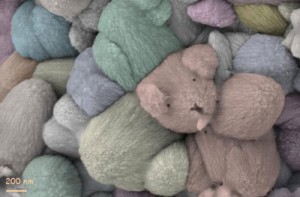 1. The Nano Teddy Bear which shows zinc oxide nanostructures deposited on an indium oxide coated glass substrate using an electrochemical deposition technique.
1. The Nano Teddy Bear which shows zinc oxide nanostructures deposited on an indium oxide coated glass substrate using an electrochemical deposition technique.
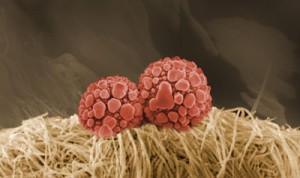 3. Nano Spaghetti and Meatballs where the ‘spaghetti’ is a collection of electrodeposited gold nanowires and the ‘meatballs’ are silicon nanoparticles.
3. Nano Spaghetti and Meatballs where the ‘spaghetti’ is a collection of electrodeposited gold nanowires and the ‘meatballs’ are silicon nanoparticles.
 4. Nanoflower made of crystalline wurtzite indium nitride made using a molecular bean epitaxy process.
4. Nanoflower made of crystalline wurtzite indium nitride made using a molecular bean epitaxy process.
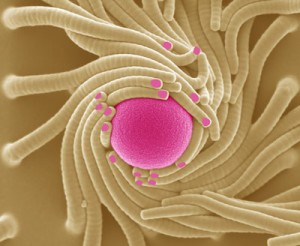 5. The Nano-Grip composed of thick epoxy crystals self-assembled onto a 2.5 micron polystyrene sphere.
5. The Nano-Grip composed of thick epoxy crystals self-assembled onto a 2.5 micron polystyrene sphere.
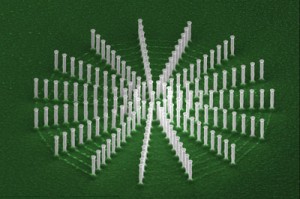 6. Modern Stonehenge consists of silicon nanopillars created using gallium implantation and deep reactive-ion etching.
6. Modern Stonehenge consists of silicon nanopillars created using gallium implantation and deep reactive-ion etching.
Lookin’ at DNA Nanostructures
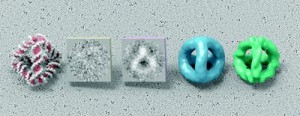 Many DNA nanostructures have been constructed by scientists for many different kinds of applications, such as drug delivery, medical diagnosis, and DNA-based computers. But in order to be successful in designing these nanostructures, we must first find out what exactly the 3D structure of DNA looks like!
Many DNA nanostructures have been constructed by scientists for many different kinds of applications, such as drug delivery, medical diagnosis, and DNA-based computers. But in order to be successful in designing these nanostructures, we must first find out what exactly the 3D structure of DNA looks like!
But how can we look at the structure DNA helix? It’s so small! Well, scientists have built powerful microscopes to try and visualize DNA. Atomic force microscopy (AFM) is a powerful technique but does not visualize in 3D very well. Another powerful tool that has been built is called the electron cryomicroscopy (cryoEM).
CryoEM can be used to look at the structure of a 7 nm self-assembled DNA tetrahedron, which is an incredible achievenment for scientists. Never before has such a small biological molecule been looked at with such high resolution!
The Creepy Crawling Nano-Fiber Vacuum
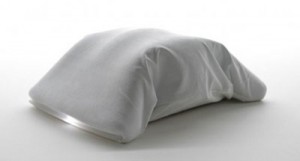 Tired of mopping and sweeping your floors? Now cleaning has become so much easier!
Tired of mopping and sweeping your floors? Now cleaning has become so much easier!
Let this new crawling vacuum introduced by Panasonic do all the dirty work! It’s called Fukitorimushi, which means “Wipe-up Bug” in japanese. Working with textile maker Teijin, they have developed an autonomous floor-cleaning robot that crawls around like an inchworm. The robot is covered in a super-absorbent polyester nanofiber cloth that picks up microscopic dust and residue that ordinary vacuums leave behind.
The specially designed nanofibers significantly increase the fabric’s surface area and porosity, giving it super wiping characteristics and the ability to absorb oil and ultra-fine dust particles less than one micrometer in diameter. How small is a micrometer? Well, to give you an idea, a single human hair is approximately 100 micrometers in diameter. So it’s really small! The large surface contact area also increases the fabric’s friction with the floor, allowing it to use this friction to push itself forward while wiping the floor. Check out the cool video!
Nano Tattoo for Diabetics
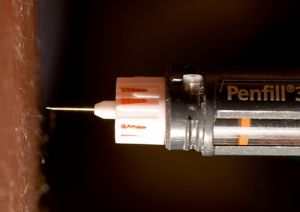 For many, tattoos allow people to express their style. But did you know that in the near future, tattoos may become a means of treating disease? Diabetics who monitor their blood sugar levels often have endure many needle pricks every day. However, Heather Clark of Draper Laboratory in Massachusetts is developing a new tattoo ink that changes color based on glucose levels inside the skin.
For many, tattoos allow people to express their style. But did you know that in the near future, tattoos may become a means of treating disease? Diabetics who monitor their blood sugar levels often have endure many needle pricks every day. However, Heather Clark of Draper Laboratory in Massachusetts is developing a new tattoo ink that changes color based on glucose levels inside the skin.
So how does it work? The dye is made up of tiny plastic nanoparticles. When the glucose is low, the particle is yellow and fluorescent, but when glucose levels increase, the fluorescence goes away and the particles turn purple. Though this tattoo would have to be periodically re-injected because it would shed along with the skin, it’s a major step up from the daily needle pricks!
Scientists hope that this technology will be up and running in the next five to ten years.
Source: Earth and Sky
My Head is in the Clouds…
 … and what do I see? Bacteria! Pollen! Fungi! What’s going on? A team of atmospheric chemists at University of California at San Diego have performed the first-ever direct detections of biological particles inside ice clouds. Taking samples of water droplets and ice crystal residues using a mass spectrometer while flying at high speeds through clouds in the skies of Wyoming, these researchers have revealed that the growth ice crystals were initiated almost entirely of dust or biological material, such as bacteria, fungal spores, and plant material.
… and what do I see? Bacteria! Pollen! Fungi! What’s going on? A team of atmospheric chemists at University of California at San Diego have performed the first-ever direct detections of biological particles inside ice clouds. Taking samples of water droplets and ice crystal residues using a mass spectrometer while flying at high speeds through clouds in the skies of Wyoming, these researchers have revealed that the growth ice crystals were initiated almost entirely of dust or biological material, such as bacteria, fungal spores, and plant material.
Though it has long been known that microorganisms become airborne and travel great distances, this is the first study that analyzes their influence on cloud formation. Researchers have found that the ice crystal residues were half made up of mineral dust and a third were made up of inorganic ions mixed with nitrogen, phosphorus, and carbon – the signature elements of biological matter.
If we can understand how these particles cause cloud formation, we can then determine the impact they have on the climate. For example, some scientists believe that the dust transported from Asia could be impacting the rainfall in North America!
Source: NSF Press Release 09-100
Playing Pinball with Atoms
 Many of you may have played pinball in an arcade before. How small is that pinball be? The size of a marble? The size of an ant? What if you could play pinball with something much much smaller? What’s the smallest thing you can think of?
Many of you may have played pinball in an arcade before. How small is that pinball be? The size of a marble? The size of an ant? What if you could play pinball with something much much smaller? What’s the smallest thing you can think of?
Researchers in the Netherlands have developed an atomic scale mechanical device by using electrical current to make two atom pairs behave like the flippers on a atomic-sized pinball machine.
On a piece of germanium, platinum atoms heated under a very high vacuum, which causes them to form dimer chains. Platinum dimers are structures that consist of two platinum atoms linked together. When electrons are injected into the platinum dimers using a scanning tunneling microscope tip, the atom pairs can switch to as many as six different configurations!
Source: ACS Publications
Harnessing the Power of Viruses
 Researchers at MIT have genetically engineered viruses to build the positively and negatively charged ends of a lithium ion battery. With the same energy capacity and power performance as state-of-the-art rechargeable batteries, they could be used to power plug-in hybrid cars and a range of personal electronics.
Researchers at MIT have genetically engineered viruses to build the positively and negatively charged ends of a lithium ion battery. With the same energy capacity and power performance as state-of-the-art rechargeable batteries, they could be used to power plug-in hybrid cars and a range of personal electronics.
For the cathode, these genetically engineered viruses are built to coat themselves with iron phosphate, then self-assemble onto carbon nanotbues to create a network of highly conductive material. These viruses are a common bacteriophage, which infect bacteria but art harmless to humans.
Part of a recent wave of clean-energy technologies, these battery prototypes are lightweight, flexible, and pending commercial production.
Source: Eurekaalert
The Physics of Pizza Tossing
 Interested in learning the art of a perfect pizza toss? Well, so are Monash University scientists who are studying the pizza toss in order to design the next generation of micro motors thinner than a single human hair. How does the dough travel through the air? How much does the dough rotate? How quickly does it spin?
Interested in learning the art of a perfect pizza toss? Well, so are Monash University scientists who are studying the pizza toss in order to design the next generation of micro motors thinner than a single human hair. How does the dough travel through the air? How much does the dough rotate? How quickly does it spin?
The Monash’s team of scientists are modeling the pizza toss mathematically, and have found that tossing pizza dough continuously without stopping to catch it requires your hands to move in circles. This model could help researchers design better ultrasonic motors, which operate on similar principles as pizza tossing. In the future, these tiny motors could be used in minimally invasive neuro-microsurgery procedures, giving surgeons more control and precision during brain surgery.
Source: EurekAlert!
Image Source: Seattlepi.com

